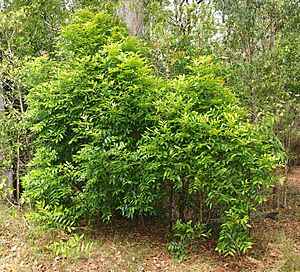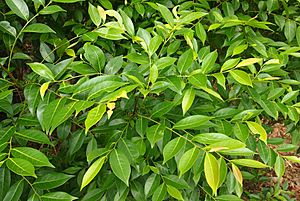Glochidion ferdinandi facts for kids
The Cheese Tree (scientific name: Glochidion ferdinandi) is a small to medium-sized tree found in eastern Australia. It belongs to the plant family called Phyllanthaceae. You can find these trees growing naturally in rainforests and moist eucalyptus forests, from New South Wales all the way up to Queensland. Many birds, like pigeons, figbirds, and parrots, love to eat its fruit.
Quick facts for kids Glochidion ferdinandi |
|
|---|---|
 |
|
| Habit | |
| Scientific classification | |
| Genus: |
Glochidion
|
| Species: |
ferdinandi
|
| Synonyms | |
|
|
Contents
What the Cheese Tree Looks Like
The Cheese Tree can grow as a woody bush or a small tree. It usually reaches about 8 meters (26 feet) tall, but some can grow as tall as 30 meters (98 feet)! It has bark that is brownish-grey and peels off in flakes.
Its leaves are simple and shaped like an oval. They are arranged alternately along the branches. Each leaf is about 3 to 10 centimeters (1.2 to 4 inches) long and 1.5 to 4 centimeters (0.6 to 1.6 inches) wide. In winter, the tree might lose some of its leaves.
The Cheese Tree can flower at any time of the year. It has both male and female flowers on the same tree. The flowers are green-yellow. Male flowers are about 0.7 centimeters (0.3 inches) across, and female flowers are about 0.5 centimeters (0.2 inches) across.
The most interesting part is its fruit! They look like tiny pumpkins and are green at first. As they ripen, they turn white and pink. The fruit is divided into sections, like a cheese wheel. When they are ready, they split open to show bright red seeds, each about 0.5 centimeters (0.2 inches) big. You can see these fruits from November to April.
Why It's Called the Cheese Tree
The common name "Cheese Tree" comes from its fruit. They really do look like small wheels of cheese! People also call this tree by other names, such as water gum, button wood, pencil cedar, and jow-war.
The scientific name of the tree is Glochidion ferdinandi. A Swiss botanist named Johannes Müller Argoviensis first described it in 1865. He called it Phyllanthus ferdinandi. Later, in 1902, Frederick Manson Bailey gave it its current name. The "ferdinandi" part of the name honors Ferdinand von Mueller, who was a botanist from Victoria, Australia.
There is also a less common type of Cheese Tree called pubens, or the hairy cheese tree. It is smaller and has slightly hairy leaves and fruit.
Where the Cheese Tree Grows
The Cheese Tree grows well in different types of soil, including clay and sandy soils. You can find it in rainforests and wetter areas of eucalyptus forests. It often grows alongside other trees like the bangalay, woollybutt, and swamp she-oak. The hairy cheese tree often grows with magenta lilly pilly and broad-leaved paperbark.
This tree is found across a wide area of eastern Australia. It grows from central Queensland down to the southern part of New South Wales, near a town called Ulladulla.
Animals and the Cheese Tree
Many animals rely on the Cheese Tree. Its fruits are a favorite food for several bird species. These include the Australasian figbird, Lewin's honeyeater, olive-backed oriole, white-headed pigeon, topknot pigeon, brown cuckoo-dove, and Australian king parrot. Even the pied currawong eats the fruit, though it spits out the seeds.
Young, fresh leaves of the Cheese Tree are a snack for the rainbow lorikeet. The tree is also important for some butterflies. The caterpillars of the shining pencil-blue and the shining- or common oak-blue butterflies eat its leaves.
Tiny ladybirds, like the Scymnodes lividigaster, help the tree by eating aphids. Aphids are small insects that feed on the Cheese Tree's sap.
How the Cheese Tree Reproduces
The Cheese Tree has a special relationship with tiny moths called leafflower moths (Epicephala species). These moths help the tree with pollination, which is how plants make seeds. In return, the moths lay their eggs inside the tree's flowers. When the eggs hatch, the caterpillars eat some of the developing seeds.
One type of leafflower moth, Epicephala colymbetella, has been found in the fruit of the Cheese Tree. What's interesting is that the Cheese Tree's fruit has empty spaces inside. The E. colymbetella caterpillars use these spaces to turn into pupae, and then the adult moths emerge from there. It's a unique way for the moths to complete their life cycle while helping the tree.
The Cheese Tree can live for a long time, sometimes 60 years or more. If there's a bushfire, it can often grow back from its roots or trunk. Its seeds usually take 1 to 4 months to sprout.
Growing the Cheese Tree
The Cheese Tree is an easy plant to grow. It's often used in projects to bring back native plants in eastern Australia. It can quickly grow in areas that have been disturbed. These trees need plenty of water but can grow in many different types of soil. They also do well in both sunny and shady spots. You can even grow a Cheese Tree indoors if you place it in a bright area.
Uses of the Cheese Tree
The dried fruits of the Cheese Tree look like tiny pumpkins. Because of this, they are often used in potpourri and sold as "putka pods" for decoration.
See also
 In Spanish: Glochidion ferdinandi para niños
In Spanish: Glochidion ferdinandi para niños



